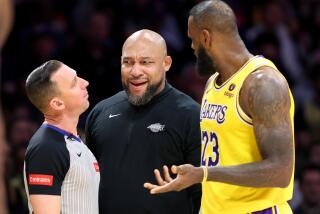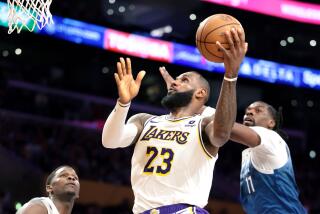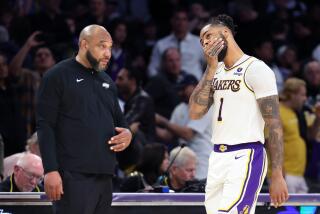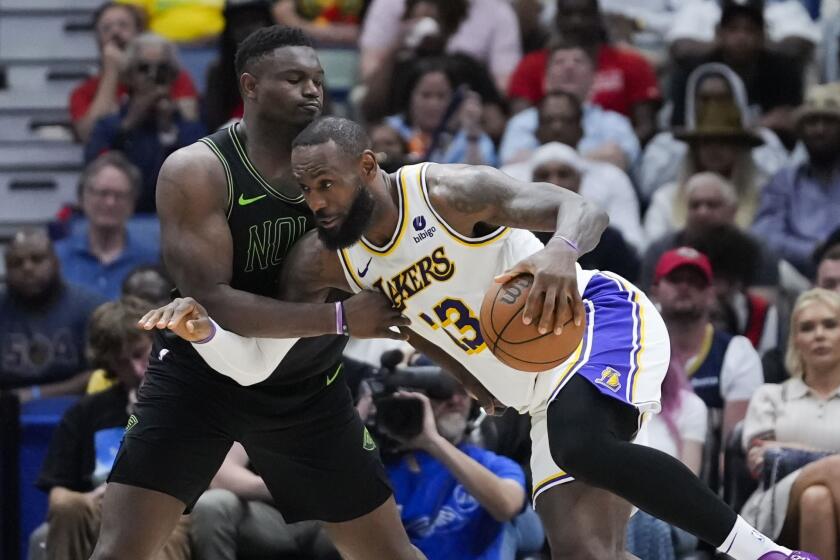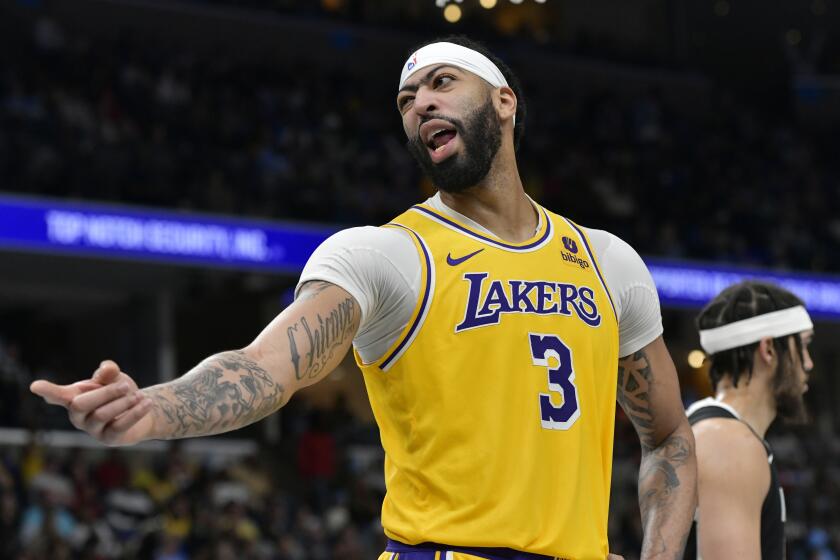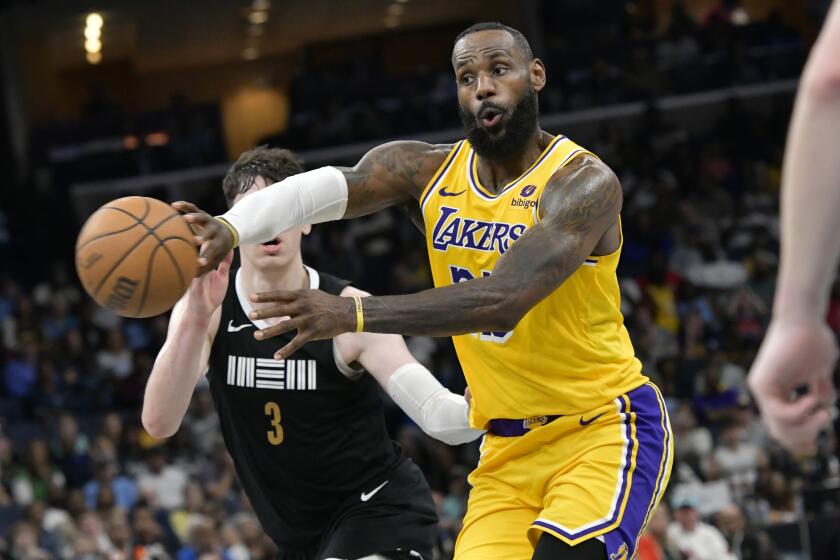Anatomy of a train wreck: How Lakers’ season went from bad to worst
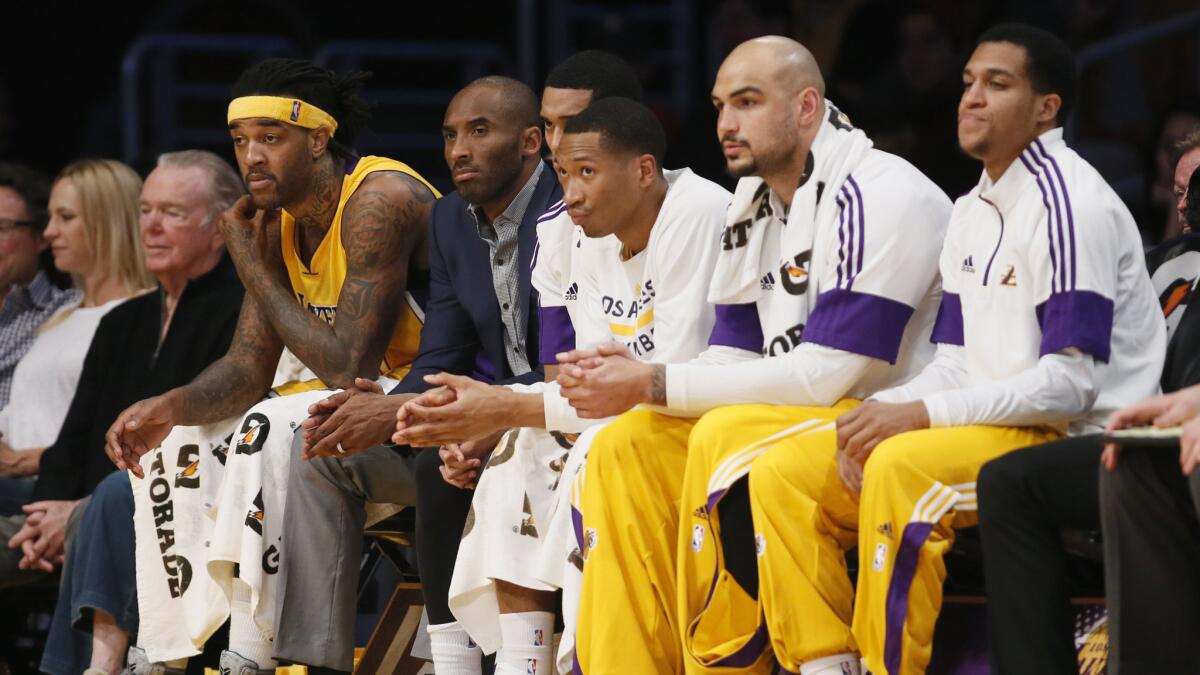
Injured
The air inside Citizens Business Bank Arena in Ontario was extremely cold last October when the Lakers arrived to entertain their large Inland Empire fan base in a meaningless exhibition game.
The building is also home to a minor league hockey team, so below the temporary court was a layer of ice, inches from where the teams were playing.
Cold also described the Lakers.
Kobe Bryant missed 10 of his 13 shots and Steve Nash left the game at halftime because he didn’t feel quite right. The Lakers lost to the Golden State Warriors by a staggering 116-75, their largest loss in an exhibition since 1984.
First-year Coach Byron Scott was troubled but not alarmed. As a player during the Lakers’ high-flying Showtime years, he knew there would be bumps and figured the problems could be fixed.
He was wrong.
What followed the next six months was unheard of in Lakers history. The team finished with a 21-61 record, becoming the worst team in the 67-year existence of the franchise.
How did it get like this?
Old age. Injuries. Bloated contracts. Trades that didn’t work. An unlucky amateur draft. And the Kobe of 2015 is not the Kobe of 2005.
No one could have predicted how bad it would get.
::
Nash arrived in July 2012, the alleged answer to the Lakers’ need for an on-court quarterback. He had run the point-guard position with great skill in Phoenix, twice earning the NBA’s most-valuable-player award. The Lakers happily gave up two first-round draft picks and two second-round choices to get him from the Suns. They also gave him a three-year, $28-million contract. He was 38 years old.
Nash played only 65 games in those three seasons and didn’t even make it to the regular season this season. That exhibition game in Ontario was the last time he ever played for the Lakers.
Two weeks later, Nash would declare himself done for the season because of recurring back problems. Two weeks after that, he posted to Instagram a brief video of himself hitting a golf ball at a driving range. People cheered in the background because he appeared to hit the ball a solid distance.
Lakers fans were not amused and fired back on social media. It might have been displaced anger because they were still dealing with an injury to a different player.
Highly touted rookie Julius Randle broke his right leg in the Lakers’ regular-season opener after an awkward plant on a drive to the basket. He later cried in the arms of his coach because his season was over after only 14 minutes.
If Nash’s back problems were age-driven, this was merely misfortune, though also another premonition of bad things to come.
::
The Lakers lost 10 of their first 16 games and Bryant was clearly frustrated.
He unleashed a tirade at practice, calling teammates “soft like Charmin” and yelling at Mitch Kupchak, the team’s general manager, to find better players for Bryant to practice against.
“I just challenge guys, see what happens,” Bryant said an hour later. “I’ve always believed in throwing them in the pool and then seeing if they can sink or swim.”
Lakers fans had grown accustomed to Bryant, 36, performing at a high level and routinely overlooked his age. The team had shown its confidence in the aging star when it gave him a two-year, $48.5-million contract extension in 2013 despite his having torn an Achilles’ tendon six months earlier.
The Lakers were taking precautions this season with their chief asset. Bryant essentially became a part-time player, sitting out eight of 16 games in one stretch so he would be rested. In his 35th game, he injured his shoulder on a routine dunk. Bryant was shooting a career-low 37.3%.
A fractured kneecap had sidelined him the previous season and now a torn rotator cuff had ended this season.
Bryant has one more year on his contract, for $25 million, a lot of money for a player who will enter his 20th, and likely final, NBA season in the fall.
Bryant was not alone in being hurt. Nine Lakers backcourt players failed to finish the season because of injuries, including Bryant and Nash.
::
There was also the curious case of reserve forward Nick Young, the self-dubbed “Swaggy P.” He says the “P” stands for prophet.
He had a career-worst 36.6% shooting percentage this season and constantly confused his coach and teammates with unpredictable shot selection. The normally upbeat Young waged Twitter battles with an ESPN anchor and rapper Snoop Dogg because they’d poked fun at his girlfriend, pop star Iggy Azalea.
Young was criticized by Scott and Bryant for being part of an over-the-top postgame celebration on the court after the Lakers beat Boston in February to improve to 14-41. It turned out to be Young’s last game of the season because of a fractured kneecap.
Veterans Jeremy Lin and Carlos Boozer, discards from other teams, were of minimal help throughout the season, shuffled in and out of the starting lineup and never quite comfortable with Scott’s system.
By the end of the season, the Lakers’ starters were unrecognizable, including two guards who spent a majority of the season with the team’s minor league affiliate.
Lakers fans even started to cheer for their team to lose in hopes it would be rewarded with a top player in the June draft. The worse a team’s record, the better the chance of landing a top college player. In basketball, one player can turn the fortunes of a franchise much easier than most sports.
The Lakers’ situation is complicated this year by the fact that, if they don’t land one of the top five picks in the NBA draft lottery next month, they will lose their selection — one of the terms of the Nash trade.
Magic Johnson, an unpaid vice president for the Lakers, became the unofficial spokesman for the lose-first mind-set by saying the team should “lose every game” when he recognized how bad the Lakers would be.
The season mercifully ended on Wednesday with a 122-99 loss to the Sacramento Kings that ensured the team would finish with a worse record, in terms of winning percentage, than the 1957-58 Minneapolis Lakers, previously the worst-performing team in franchise history. The fans started cheering when it was announced that only two minutes remained in the game at Staples Center.
::
Two straight seasons of terrible basketball has also hurt the team’s bottom line. Normally an automatic sellout, the team did not sell out nine of the 41 home games for the second season in a row.
“I’m not getting season tickets until they turn the team around,” said Andrew Alper, an attorney who gave up his season tickets this season. “I’m not going to buy tickets to see a product that’s going to continue to lose.”
Still, there are loyal fans. But even their patience is wearing out.
“I still believe in the brand but I feel like this next off-season is where people feel like jumping ship a little bit,” said Fred Equchi, a season ticket holder for eight years. “That’s kind of where everybody in my section is at.”
One way the team can improve is in the draft on June 25. The Lakers finished with the fourth-worst record, putting themselves in prime position to acquire a young, talented player. Their eventual pick will be determined in the lottery, a weighted draw on May 19.
There are other options for the Lakers to get better next season. They can spend money on free agents in July. There are no franchise-changers available this summer, though the team will pursue at least one good player, if not two. Next year, Oklahoma City’s Kevin Durant, the league MVP last season, is expected to become a free agent, and if he came to the Lakers he could easily replace Bryant as the marquee player.
The Lakers have not done well in the free-agent market the last two years.
They couldn’t convince All-Star center Dwight Howard to stay with them after he spent one uncomfortable season in Bryant’s shadow. Howard took less money to go to Houston in 2013.
Last year, they couldn’t sign high-scoring free agent Carmelo Anthony from New York, or talk Pau Gasol into staying with them. Gasol won championships with the Lakers in 2009 and 2010 but took less money to go to Chicago, where he quickly returned to All-Star form.
The Lakers could lean on a more memorable part of their past — 16 NBA championships — while pitching free agents, but they don’t.
“We rarely sell the past and the legacy here,” Kupchak said. “The players really don’t want to hear about it. They want to hear about the team you’re building, the opportunity, and what they’ll be looking at going forward.”
Right now, the future is all the Lakers can peddle, a startling truth for a franchise with such a rich past.
Follow Mike Bresnahan on Twitter @Mike_Bresnahan
More to Read
All things Lakers, all the time.
Get all the Lakers news you need in Dan Woike's weekly newsletter.
You may occasionally receive promotional content from the Los Angeles Times.
